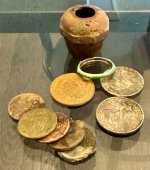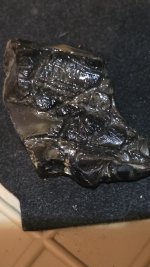4Strokes1Pick&Poke
Full Member
- May 3, 2016
- 163
- 105
- Detector(s) used
- Garret Pin pointer pro AT. "Other" methods.
- Primary Interest:
- Prospecting
Just wondering if anyone has any pictures of these type of ore in your area?
In fact, try this first just so you understand what sulfuric acid can do to you. Take a small Pyrex vessel; put about an inch of common sugar in it. Now slowly pour in enough concentrated sulfuric acid to just wet it. Do this outside or in a place where nothing can get away. Now just stand back and watch it for a few minutes. Think what that could do to you, and, I guarantee that it will do the same to you. No, I’m not going to tell you what happens. Try it, you will never again treat concentrated sulfuric acid with disrespect.
Tellurides
There is a metal that no one knows much about, Tellurium. Go to "links", "periodic table of elements", and you will find all the chemical characteristics of this element. It is a metal with a lot of chemical properties similar to gold. No, it’s not a precious metal, but it does have a unique property. It forms natural salts (complexes) with gold. Some of the most valuable gold ores that exist are in the form of Tellurides. Yeah, I know, someone told you that gold was inert, it doesn’t combine with anything in nature. It only occurs as the elemental metal, GOLD. Well, as usual, they told you wrong. I’m sure they believed it, their best buddy told them, so it must be true. The buddy only had hearsay evidence, old wives tales. We Basement Chemists only believe the tales that can be substantiated. Sure we all know that there is gold dissolved in sea- water as the salt, gold chloride. True, but the amount is so small that, for our purposes, it can be ignored. We ain’t gonna get rich on that.
I know someone is going to say, " gold comes, in nature, combined with mercury, silver, copper, etc, I find it all the time. These amalgams that we all find once in awhile, are not "combined". they are not another chemical. They are not salts of gold, mercury, silver, or copper. They are simply mixtures of gold, silver, copper, and mercury. They have not chemically reacted to form another compound.
OK, so what the heck is a Telluride anyway? Well, you should have caught on by now that when a chemical name ends in "ide" it means that it is a salt. The things are chemically combined, not just mixed or dissolved in each other. Hydrogen sulfide is not hydrogen dissolved in sulfur. It is hydrogen reacted with sulfur to produce a completely different chemical. If not, you could simply warm the hydrogen sulfide and it would boil off hydrogen and leave sufur behind. It don’t work that way. They are reacted to form a chemical that is not hydrogen nor sulfur. It’s a completely different thing.
Tellurium, gold, and silver (and other metals) can react to form Tellurides. Why are they not called "goldides"? Don’t know. I think it just don’t sound as good. Actually, it is because you can have tellurium/silver, tellurium/gold, or tellurium/silver/gold. You cannot have silver/gold. That is an amalgam, a mixture, not a compound.
There are a few tellurides that are of interest to prospectors/miners.
Calaverite: AuTe2
Calaverite is the name given to a telluride that occurs in certain areas as a brown/black, friable material that if you pan it out might very well show no gold at all. However, this stuff can be the "Elvis Pressley" of gold ores. All you guys have heard of a place called "Telluride" Colorado, right? The reason they called it that was that they had deposits of tellurides that were yielding so much gold you couldn’t believe it. Calaverite is the ore that you want to find. It can assay from 20- 70% gold and it is easy to recover. You and I have probably walked on it, dug it, looked at it, thrown it away, and moved on to better spots. The problem is that it doesn’t look like gold. You might not see even a color, or as we say here "ni un ojo de zancudo" (not even a mosquito eye). This ore is metallic and is amenable to amalgamation with mercury. It is very heavy and can be caught in sluices etc. It, however, does not look like gold, is not yellow, and is usually tossed out with the black sands. It appears more like gold/mercury amalgam than gold but it is not quite that either.
It would probably be worth your time to visit a nearby university etc and ask them to show you some samples of Calaverite, just so you know what it looks like. Maybe they would give you some so that you would have it to compare with any suspect ore. This ore is not one that you would want to miss. A little deposit of this stuff could make your whole year.
If you should get into a deposit of this material, be careful. Don’t throw anything away until you are sure it has no gold in it. If you should discard a small percentage of Calaverite, at 60% gold, it could be big bucks.
Altaite
This is another telluride of silver/gold. Not so significant as the above.
Sylvanite
A telluride of gold and silver. It can assay as high as 20% gold.
Petzite
Another telluride that is mostly silver. Silver content is usually twice that of gold.
Hessite
Resembles Petzite. Usually about 60% silver
In fact, try this first just so you understand what sulfuric acid can do to you. Take a small Pyrex vessel; put about an inch of common sugar in it. Now slowly pour in enough concentrated sulfuric acid to just wet it. Do this outside or in a place where nothing can get away. Now just stand back and watch it for a few minutes. Think what that could do to you, and, I guarantee that it will do the same to you. No, I’m not going to tell you what happens. Try it, you will never again treat concentrated sulfuric acid with disrespect.
Tellurides
There is a metal that no one knows much about, Tellurium. Go to "links", "periodic table of elements", and you will find all the chemical characteristics of this element. It is a metal with a lot of chemical properties similar to gold. No, it’s not a precious metal, but it does have a unique property. It forms natural salts (complexes) with gold. Some of the most valuable gold ores that exist are in the form of Tellurides. Yeah, I know, someone told you that gold was inert, it doesn’t combine with anything in nature. It only occurs as the elemental metal, GOLD. Well, as usual, they told you wrong. I’m sure they believed it, their best buddy told them, so it must be true. The buddy only had hearsay evidence, old wives tales. We Basement Chemists only believe the tales that can be substantiated. Sure we all know that there is gold dissolved in sea- water as the salt, gold chloride. True, but the amount is so small that, for our purposes, it can be ignored. We ain’t gonna get rich on that.
I know someone is going to say, " gold comes, in nature, combined with mercury, silver, copper, etc, I find it all the time. These amalgams that we all find once in awhile, are not "combined". they are not another chemical. They are not salts of gold, mercury, silver, or copper. They are simply mixtures of gold, silver, copper, and mercury. They have not chemically reacted to form another compound.
OK, so what the heck is a Telluride anyway? Well, you should have caught on by now that when a chemical name ends in "ide" it means that it is a salt. The things are chemically combined, not just mixed or dissolved in each other. Hydrogen sulfide is not hydrogen dissolved in sulfur. It is hydrogen reacted with sulfur to produce a completely different chemical. If not, you could simply warm the hydrogen sulfide and it would boil off hydrogen and leave sufur behind. It don’t work that way. They are reacted to form a chemical that is not hydrogen nor sulfur. It’s a completely different thing.
Tellurium, gold, and silver (and other metals) can react to form Tellurides. Why are they not called "goldides"? Don’t know. I think it just don’t sound as good. Actually, it is because you can have tellurium/silver, tellurium/gold, or tellurium/silver/gold. You cannot have silver/gold. That is an amalgam, a mixture, not a compound.
There are a few tellurides that are of interest to prospectors/miners.
Calaverite: AuTe2
Calaverite is the name given to a telluride that occurs in certain areas as a brown/black, friable material that if you pan it out might very well show no gold at all. However, this stuff can be the "Elvis Pressley" of gold ores. All you guys have heard of a place called "Telluride" Colorado, right? The reason they called it that was that they had deposits of tellurides that were yielding so much gold you couldn’t believe it. Calaverite is the ore that you want to find. It can assay from 20- 70% gold and it is easy to recover. You and I have probably walked on it, dug it, looked at it, thrown it away, and moved on to better spots. The problem is that it doesn’t look like gold. You might not see even a color, or as we say here "ni un ojo de zancudo" (not even a mosquito eye). This ore is metallic and is amenable to amalgamation with mercury. It is very heavy and can be caught in sluices etc. It, however, does not look like gold, is not yellow, and is usually tossed out with the black sands. It appears more like gold/mercury amalgam than gold but it is not quite that either.
It would probably be worth your time to visit a nearby university etc and ask them to show you some samples of Calaverite, just so you know what it looks like. Maybe they would give you some so that you would have it to compare with any suspect ore. This ore is not one that you would want to miss. A little deposit of this stuff could make your whole year.
If you should get into a deposit of this material, be careful. Don’t throw anything away until you are sure it has no gold in it. If you should discard a small percentage of Calaverite, at 60% gold, it could be big bucks.
Altaite
This is another telluride of silver/gold. Not so significant as the above.
Sylvanite
A telluride of gold and silver. It can assay as high as 20% gold.
Petzite
Another telluride that is mostly silver. Silver content is usually twice that of gold.
Hessite
Resembles Petzite. Usually about 60% silver





